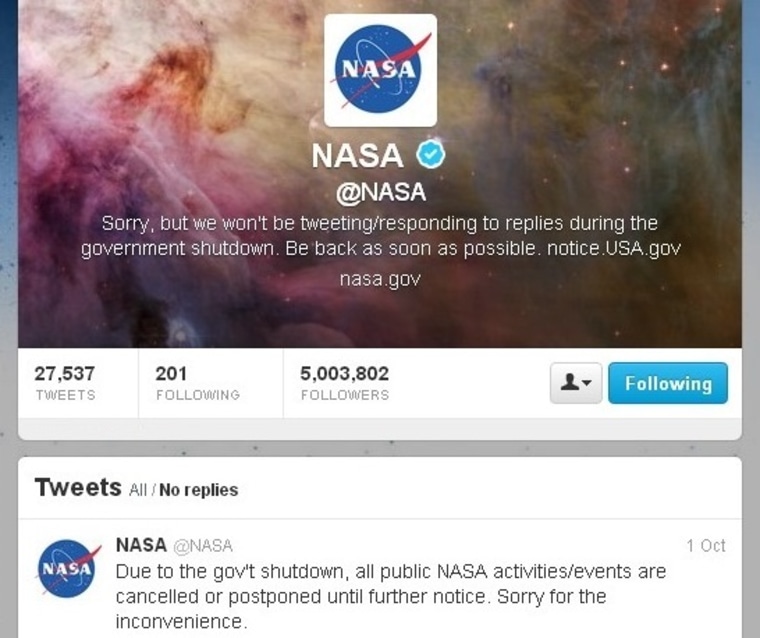The Curiosity rover is sending back wild pictures of Martian boulders ... physicists are winning the Nobel Prize for their theories about the "God Particle" ... planetary scientists are gathering for one of their biggest meetings of the year ... and the federal government is shut down.
That last fact affects all the others, at least in terms of how NASA and other federal agencies get the word out about what's going on in the world of science. For the most part, the shutdown has forced those agencies to close down their social media campaigns, stop updating their websites and shut off their video streams.
Twitter users have stepped into the breach, using the hashtag #ThingsNASAMightTweet to pass along updates about space missions and more — such as the Juno probe's impending flyby of Earth en route to Jupiter. The hashtag was created by Bill Dunford (a.k.a. @ridingrobots), who works at a software company in Utah and runs an educational website called Riding With Robots.
"I thought, 'Why don't I start tweeting what NASA can't," Dunford told Mashable.
Getting around the shutdown
Some of the Twitter users filling the gap just happen to be federal employees.
For example, NASA spokesman Bob Jacobs has been passing along space tidbits from his personal @bnjacobs Twitter account, which provides no indication that he works for the space agency. Don't expect him to answer your messages. "Sorry, want to be responsive but we're not allowed to answer even on personal accounts," Jacobs told one inquiring Twitter correspondent.
Fermilab's head of communications, Katie Yurkewicz, has been retweeting reports about Tuesday's Nobel physics prize — which relates to the discovery of the Higgs boson, an achievement that involved hundreds of scientists from Fermilab and other federally supported labs participated. But only one tweet from her @kyurkewicz account pointed to a news release at Fermilab's website. The same news release was published on Brookhaven National Laboratory's website.
Yurkewicz told NBC News that the Nobel news was a special case. "That's it for proactive public outreach until the shutdown ends," she said.
Fermilab's website is still functional, even though it's not being updated. The same goes for some of the other federally supported science sites, ranging from Symmetry Magazine to the National Institutes of Health and the Department of Energy. In contrast, the National Science Foundation website has been stripped down to the basics.
What's up and down in space
Most NASA websites are inaccessible, including NASA TV online and on cable TV. NASA's Jet Propulsion Laboratory is one of the rare exceptions: Although most of the website has been frozen in pre-shutdown mode, raw images from the Curiosity and Opportunity rovers on Mars are still being added. A similar situation applies to raw imagery from the Solar Dynamics Observatory and the Solar and Heliospheric Observatory.
Some of NASA's other databases, such as Johnson Space Center's Gateway to Astronaut Photography of Earth and Kennedy Space Center's Media Gallery, are still accessible, though they're not being updated.
Meanwhile, space mission websites that aren't housed under NASA.gov are plugging along: That includes Cassini pictures from Saturn, Messenger pictures from Mercury, HiRISE pictures from Mars, Lunar Reconnaissance Orbiter pictures from the moon, and information about the Hubble Space Telescope and the Chandra X-ray Observatory. You can still get space weather reports from NOAA's Space Weather Prediction Center and SpaceWeather.com, too.
Whether or not the websites are working, NASA is still funding ongoing space missions, including activities on the International Space Station. NASA astronauts Karen Nyberg (@AstroKarenN) and Mike Hopkins (@astroillini) are continuing to tweet from orbit, along with Italy's Luca Parmitano (@astro_luca). But most missions yet to be flown have been put on hold — with the notable exception of the Maven mission to Mars.
Some federally funded science operations have been using money left over from the previous fiscal year to stay in operation, but that cash can go only so far. The Science Insider blog reported that the National Radio Astronomy Observatory's U.S.-based network of radio telescopes came to a "dead halt" on Friday when funds ran out. Some money is still going toward the ALMA telescope array in Chile and the Arecibo Observatory in Puerto Rico. But the longer the shutdown continues, the less science will get done.
More about the shutdown and science:
- Shutdown could put Antarctic research in deep freeze
- Shutdown stops Smithsonian's T. rex in its track
- Shutdown creates 'deep hardship' for scientists
The shutdown's implications for science are generating a lot of tweets at this week's meeting of the American Astronomical Society's Division for Planetary Sciences (even though federally employed scientists can't participate). To follow the discussion, keep tabs on the #DPS13 hashtag.
Alan Boyle is NBCNews.com's science editor. Connect with the Cosmic Log community by "liking" the NBC News Science Facebook page, following @b0yle on Twitter and adding +Alan Boyle to your Google+ circles. To keep up with NBCNews.com's stories about science and space, sign up for the Tech & Science newsletter, delivered to your email in-box every weekday. You can also check out "The Case for Pluto," my book about the controversial dwarf planet and the search for new worlds.
